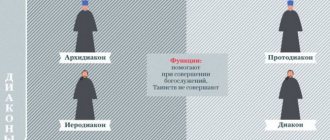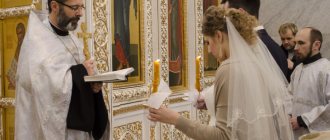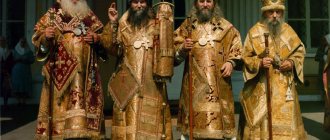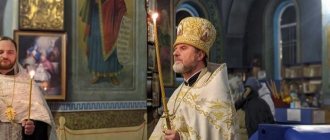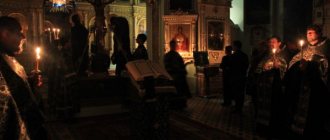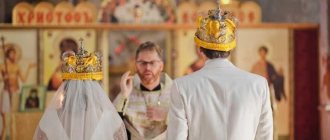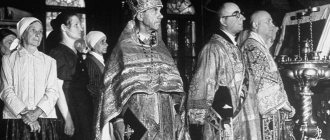Three groups of Orthodox ranks
The Russian Orthodox Church has a three-tier hierarchy, which arose at the dawn of Christianity.
The Orthodox people are divided into 3 types - depending on the degree of closeness to church sacraments and on their powers.
Lay people
These are ordinary Christians who believe in God and have not taken on the clergy. They are allowed to carry out some rituals themselves at home (for example, the consecration of an apartment). The laity are also close to the church and God through prayers, rites of baptism, weddings, funeral services for loved ones and the Orthodox faith. Also, ordinary believers are the bulk of the participants in all services.
Clergymen
They are dressed in clothing appropriate to the rank, but do not belong to the main hierarchy of clergy. They are ordained by ordination (with the blessing of the bishop/rector of the temple) and subsequently become assistant clergy:
- the subdeacon helps the bishop in divine services (nowadays, students of theological seminaries more often become subdeacons);
- the psalmist (otherwise a reader, singer) reads prayers and sings during the service;
- A sexton (otherwise a sexton, an altar boy) can perform one or more of the following functions: ring the bell to call for services, assist the priest at the altar.
Clergy
They perform the sacraments of worship, call the laity to the Christian faith, and generally manage the affairs of the church.
The clergy may be as follows:
- “White” - those who are allowed to have a family, children (but some of them still take a vow of celibacy).
- “Black” - monks who have taken monastic vows, without a family. Only monks are allowed to manage the parish.
At the dawn of Christianity, sextons and clergy were guardians of church property and holy places. Their duties also included lighting lamps, preparing utensils for worship, bringing holy water, blessed wine and bread to the service, and cleaning the church. Nowadays, these functions are divided between cleaners, watchmen, and novices.
In ancient times, there was another rank - deaconesses, who cared for sick women and helped in preparation for the rite of baptism.
Degrees of the priesthood
In Orthodoxy there are 3 degrees of priesthood:
- deacon;
- priest;
- bishop.
The listed ranks are found among the “white” and among the “black” clergy.
Degrees of the priesthood
Deacon
This is the lowest sacred rank (from the Greek “servant”). The bishop initially ordains a deacon in the Sacrament of Priesthood by ordination (handshake).
The deacon takes part in divine services together with the priest and bishop, but does not have the right to perform them alone. But sacraments and divine services can take place without a deacon.
The white clergy has the titles of “deacon” and “protodeacon” (senior deacon). In the black clergy there are the ranks of hierodeacon and archdeacon (senior deacon).
Priest
These are the so-called ministers of the middle level of clergy. They are priests, presbyters (“elders”). The priest is authorized to conduct the rites of baptism and communion, but cannot determine the places of other priests in the hierarchy, nor can he bestow grace on those around him. The priest at the head of the parish is called the rector.
Today this degree is available only to men of high moral principles, over 30 years of age and with a theological education.
This also includes hieromonks, abbots, archimandrites, and archpriests.
Bishop
In Orthodoxy, the church is headed by patriarchs of national church organizations. The accepted doctrine is that for all ranks in the church the authority is the patriarch, as Jesus was for the apostles in his time.
Bishops, bishops and patriarchs have the authority to conduct any Sacraments and rituals, and to perform ordinations in relation to other ranks of the church.
It is believed that clergy of the same level are equal “by grace.” If a transition to the next level occurs, this occurs during the Liturgy in the church.
Video: Church hierarchy
The hierarchy of the Christian church is called “three-order” because it consists of three main levels: - diaconate, - priesthood, - bishopric. And also, depending on their attitude to marriage and lifestyle, the clergy is divided into “white” - married, and “black” - monastic.
Representatives of the clergy, both “white” and “black,” have their own structures of honorary titles, which are awarded for special services to the church or “for length of service.”
| Hierarchical what degree | "Secular clergy | "Black" clergy | Appeal |
| Deacon | Deacon | Hierodeacon | Father deacon, father (name) |
| Protodeacon | Archdeacon | Your Excellency, Father (name) | |
| Priesthood | Priest (priest) | Hieromonk | Your Reverence, Father (name) |
| Archpriest | Abbot | Your Reverence, Father (name) | |
| Abbess | Venerable Mother, Mother (name) | ||
| Protopresbyter | Archimandrite | Your Reverence, Father (name) | |
| Bishopric | Bishop | Your Eminence, Most Reverend Vladyka, Vladyka (name) | |
| Archbishop | Your Eminence, Most Reverend Vladyka, Vladyka (name) | ||
| Metropolitan | Your Eminence, Most Reverend Vladyka, Vladyka (name) | ||
| Patriarch | Your Holiness, Most Holy Lord |
Deacon (minister) is called so because the duty of a deacon is to serve at the Sacraments. Initially, the position of deacon consisted of serving at meals, taking care of the maintenance of the poor and sick, and then they served in the celebration of the Sacraments, in the administration of public worship, and in general were assistants to bishops and presbyters in their ministry. Protodeacon is the chief deacon in a diocese or cathedral. The title is given to deacons after 20 years of service in the priesthood. Hierodeacon is a monk with the rank of deacon. Archdeacon is the eldest of the deacons in the monastic clergy, that is, the senior hierodeacon.
A priest (priest), by the authority of his bishops and on their “instructions”, can perform all divine services and Sacraments, except for Ordination (Priesthood - Ordination to Holy Orders), the consecration of the World (Incense Oil) and the Antimins (a quadrangular plate made of silk or linen material with sewn-in particles relics on which the Liturgy is celebrated). Archpriest is a senior priest, the title is given for special merits, and is the rector of the temple. Protopresbyter is the highest rank, exclusively honorary, given for special church services on the initiative and decision of His Holiness the Patriarch of Moscow and All Russia. Hieromonk is a monk who has the rank of priest. Hegumen is the abbot of the monastery, and in women's monasteries it is the abbess. Archimandrite is a monastic rank given as the highest award to the monastic clergy. Bishop (guardian, overseer) - not only performs the Sacraments, the Bishop also has the power to teach others through Ordination the grace-filled gift of performing the Sacraments. The bishop is the successor of the apostles, having the grace-filled power to perform all seven sacraments of the Church, receiving in the Sacrament of Ordination the grace of archpastorship - the grace of governing the Church. The episcopal degree of the sacred hierarchy of the church is the highest degree on which all other degrees of the hierarchy (presbyter, deacon) and lower clergy depend. Ordination to the rank of bishop occurs through the Sacrament of the Priesthood. The bishop is elected from the religious clergy and ordained by the bishops. An archbishop is a senior bishop who oversees several ecclesiastical regions (dioceses). Metropolitan is the head of a large ecclesiastical region uniting dioceses (metropolis). Patriarch (forefather, ancestor) is the highest title of the head of the Christian church in the country. In addition to the sacred ranks in the church, there are also lower clergy (service positions) - altar servers, subdeacons and readers. They are classified as clergy and are appointed to their positions not through Ordination, but by bishop’s or abbot’s blessing.
Altar boy is the name given to a male layman who helps the clergy at the altar. The term is not used in canonical and liturgical texts, but became generally accepted in this meaning by the end of the 20th century. in many European dioceses in the Russian Orthodox Church. The name “altar boy” is not generally accepted. In the Siberian dioceses of the Russian Orthodox Church it is not used; instead, the more traditional term sexton , as well as novice . The sacrament of priesthood is not performed over the altar boy; he only receives a blessing from the rector of the temple to serve at the altar. The duties of the altar attendant include monitoring the timely and correct lighting of candles, lamps and other lamps in the altar and in front of the iconostasis, preparing the vestments of priests and deacons, bringing prosphora, wine, water, incense to the altar, lighting coal and preparing the censer, giving payment for wiping the lips during Communion, assisting the priest in performing the sacraments and services, cleaning the altar, if necessary, reading during the service and performing the duties of a bell ringer. The altar server is prohibited from touching the throne and its accessories, as well as from moving from one side of the altar to the other between the throne and the Royal Doors. The altar server wears a surplice over lay clothes.
A subdeacon is a clergyman in the Orthodox Church, serving mainly with the bishop during his sacred ceremonies, wearing in front of him on the indicated occasions the trikirium, dikiriya and ripids, laying the eagle, washes his hands, vests him and performs some other actions. In the modern Church, a subdeacon does not have a sacred degree, although he wears a surplice and has one of the accessories of the deaconate - an orarion, which he wears crosswise over both shoulders and symbolizes angelic wings. Being the most senior clergyman, the subdeacon is an intermediate link between clergy and clergy. Therefore, the subdeacon, with the blessing of the serving bishop, can touch the throne and the altar during divine services and at certain moments enter the altar through the Royal Doors.
A reader - in Christianity - is a lower rank of clergy, not elevated to the degree of priesthood, who reads the texts of the Holy Scriptures and prayers during public worship. In addition, according to ancient tradition, readers not only read in Christian churches, but also interpreted the meaning of difficult-to-understand texts, translated them into the languages of their area, delivered sermons, taught converts and children, sang various hymns (chants), engaged in charity work, had other church obediences. In the Orthodox Church, readers are ordained by bishops through a special rite - hirothesia, otherwise called “ordaining”. This is the first ordination of a layman, only after which can he be ordained as a subdeacon, and then ordained as a deacon, then as a priest and, higher, as a bishop (bishop). The reader has the right to wear a cassock, belt and skufia. During tonsure, a small veil is first put on him, which is then removed and a surplice is put on. Monasticism has its own internal hierarchy, consisting of three degrees (belonging to them usually does not depend on belonging to one or another hierarchical degree): monasticism (ryassophore), monasticism (small schema, small angelic image) and schema (great schema, great angelic image). image). The majority of modern monastics belong to the second degree - to monasticism proper, or the small schema. Only those monastics who have this particular degree can receive Ordination to the rank of bishop. To the name of the rank of monks who have accepted the great schema, the particle “schema” is added (for example, “schema-abbot” or “schema-metropolitan”). Belonging to one degree or another of monasticism implies a difference in the level of strictness of monastic life and is expressed through differences in monastic clothing. During monastic tonsure, three main vows are made - celibacy, obedience and non-covetousness (the promise to endure all sorrow and hardship of monastic life), and a new name is assigned as a sign of the beginning of a new life.
